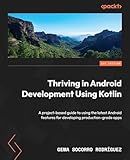Best Kotlin Development Tools to Buy in December 2025

Thriving in Android Development Using Kotlin: A project-based guide to using the latest Android features for developing production-grade apps



Kotlin Programming: The Big Nerd Ranch Guide



Learn Android Studio 3 with Kotlin: Efficient Android App Development



Head First Android Development: A Learner's Guide to Building Android Apps with Kotlin



Learn Kotlin for Android Development: The Next Generation Language for Modern Android Apps Programming



Kotlin Essentials (Kotlin for Developers Book 1)



Android UI Development with Jetpack Compose: Bring declarative and native UI to life quickly and easily on Android using Jetpack Compose and Kotlin



Beginning Kotlin: Build Applications with Better Code, Productivity, and Performance



Advanced Kotlin (Kotlin for Developers Book 4)



Modern Android 13 Development Cookbook: Over 70 recipes to solve Android development issues and create better apps with Kotlin and Jetpack Compose


In Kotlin, you can set the visibility of a button, or any other View, by using the visibility property. The visibility property accepts three constants: View.VISIBLE, View.INVISIBLE, and View.GONE.
- View.VISIBLE makes the button visible and takes up space in the layout.
- View.INVISIBLE hides the button, but it still occupies space in the layout.
- View.GONE hides the button and also removes it from the layout, so it does not take up any space.
To set the visibility of a button, you can simply call the visibility property on the button instance and assign the desired constant value. For example:
// Assuming you have a button with the id "myButton" in your layout XML val button = findViewById(R.id.myButton)
// To make the button visible button.visibility = View.VISIBLE
// To hide the button without removing it from the layout button.visibility = View.INVISIBLE
// To hide the button and remove it from the layout button.visibility = View.GONE
By using these constants, you can dynamically control the visibility of a button in your Kotlin code based on certain conditions or user interactions.
How to show a button using Kotlin?
To show a button in Kotlin, follow these steps:
- Open your Kotlin file and locate the onCreate() method of your activity or fragment.
- Find the setContentView() method and pass the corresponding layout file that contains the button.
- Declare a variable for the button using the findViewById() method, providing the button's ID as an argument.
- Set the visibility of the button to View.VISIBLE using the setVisibility() method.
- If necessary, add an OnClickListener to the button to perform an action when it is clicked.
Here's an example code snippet to demonstrate the above steps:
class MainActivity : AppCompatActivity() { override fun onCreate(savedInstanceState: Bundle?) { super.onCreate(savedInstanceState) setContentView(R.layout.activity_main)
val button = findViewById<Button>(R.id.button)
button.visibility = View.VISIBLE
button.setOnClickListener {
// Perform an action on button click
}
}
}
Make sure to replace R.layout.activity_main with the ID of the layout file that contains your button, and R.id.button with the ID of your button.
How to set button visibility based on user authentication in Kotlin?
To set button visibility based on user authentication in Kotlin, you can follow these steps:
- First, declare the button variable in your activity or fragment: val button: Button = findViewById(R.id.buttonId) // Replace buttonId with your actual button id
- Once the user authentication is done or determined, you can set the button visibility based on the result. If authentication is successful, set the visibility to View.VISIBLE; otherwise, set it to View.INVISIBLE or View.GONE. if (isUserAuthenticated()) { button.visibility = View.VISIBLE } else { button.visibility = View.INVISIBLE // or View.GONE }
- Define the isUserAuthenticated() method that checks whether the user is authenticated or not. You can implement your own logic here, such as checking shared preferences, database, or server-side authentication. private fun isUserAuthenticated() : Boolean { // Add your authentication logic here return true or false depending on the authentication status }
By following these steps, the visibility of the button will be dynamically updated based on the user authentication status.
What is the best practice for handling button visibility in Kotlin?
The best practice for handling button visibility in Kotlin is by using View Binding or Data Binding.
- Using View Binding:
- Enable View Binding in your project by adding viewBinding { enabled = true } to the app-level build.gradle file.
- In your XML layout file, assign an android:id to the button you want to handle visibility for.
- In your Kotlin code, use View Binding to access the button and handle its visibility.
Example:
// In your Kotlin Activity/Fragment private lateinit var binding: ActivityMainBinding // Replace with your generated binding class
override fun onCreate(savedInstanceState: Bundle?) { super.onCreate(savedInstanceState) binding = ActivityMainBinding.inflate(layoutInflater) setContentView(binding.root)
// For visibility GONE
binding.myButton.visibility = View.GONE
// For visibility VISIBLE
binding.myButton.visibility = View.VISIBLE
// For visibility INVISIBLE
binding.myButton.visibility = View.INVISIBLE
}
- Using Data Binding:
- Enable Data Binding in your project by adding dataBinding { enabled = true } to the app-level build.gradle file.
- In your XML layout file, wrap the button with tag, and use data tag to define a variable for button visibility.
- In your Kotlin code, use Data Binding to set up the button's visibility variable.
Example:
// In your Kotlin Activity/Fragment private lateinit var binding: ActivityMainBinding // Replace with your generated binding class ... binding = DataBindingUtil.setContentView(this, R.layout.activity_main) binding.lifecycleOwner = this
// For visibility GONE binding.buttonVisibility = View.GONE
// For visibility VISIBLE binding.buttonVisibility = View.VISIBLE
// For visibility INVISIBLE binding.buttonVisibility = View.INVISIBLE
These practices ensure a more concise and type-safe way to handle button visibility in Kotlin, improving code readability and maintainability.
